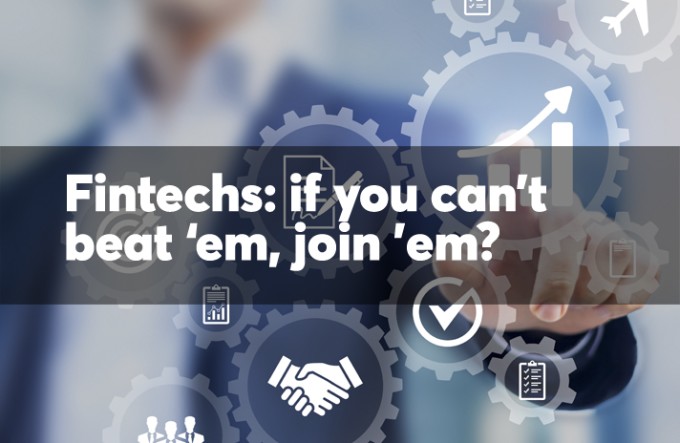June 29 2018, 11:03am EDT

With the shared goal to redefine what a multifaceted financial services model looks like to members, more credit unions are looking to partner with forward-leaning fintechs. But does this approach make sense for all credit unions?
“The biggest challenge I have seen between fintechs and credit unions is the culture shock,” said John Best, CEO of Best Innovation Group. “Fintechs are used to being lean and moving fast. They expect to have technology in place that will allow them to do this. Credit unions are a bit more slow-moving and sometimes don’t have the technology that a fintech would expect.”
During a recent web seminar exploring this topic, Capstone Managing Director John Dearing noted that over the last five years, 20 fintech companies — incuding TradeKing and Openpay — have been acquired by banks, and 40 percent of these acquisitions occurred in the last eight months. In April 2018, for example, Goldman Sachs acquired Claritymoney, a PRM app.
“We would love to have a slide next year that has credit unions on the left hand side and show all the investments that have been done through CUSOs or other partnerships,” said Dearing.
Joining Dearing was CU 2.0 founder Kirk Drake, who noted that one of the leading reasons fintechs want to partner with credit unions is because CUs have a loyal member base.
“It’s hard for a fintech to get 30,000 or 40,000 users, so there is a lot of interest partnering with credit unions,” he said.
Among barriers credit union executives face is that many fintech companies come to the table with “half-baked” concepts that “lack proof-of-concept” or a proven business model, said Drake. But he views this as an opportunity — getting in on the ground floor.
“Credit unions are risk-averse and they don’t know how to structure [fintech] deals to minimize the risk,” said Drake. And with so many new fintechs popping up, he said, it becomes difficult to pick the “winning” partner.
Whereas vendors traditionally came to credit unions with solutions designed to last five years or more, he said, fintech models are constantly evolving and may only have a shelf life of 12 to 24 months.
“Oftentimes it’s not the best tech or user interface that wins, but the business model and the market,” said Drake. “This challenges the traditional credit union vendor-management program.”
Fintech and CU success stories
Big banks are not the only FIs in the fintech game. Credit unions have thrown the proverbial hat in the ring as well, including the Boston-based Digital Federal Credit Union (DCU) and its Fintech Innovation Center.
“First and foremost, we are looking for opportunities to partner and learn from fintechs,” said David Arauno, DCU’s SVP of technology and innovation. “We are currently hosting 20 different fintech companies in our space. Some of them have alignment with our initiatives and some don’t, but regardless of alignment, it is a tremendous opportunity to learn from these entrepreneurs.”
Araujo further explained that there is “no set path for success” at the center or how best to work with fintech startups.
“We simply learn about their product, what their needs are to gain traction in financial services, educate them on our industry, and where it goes from there can vary,” he said. “We have run pilots, done proof of concepts and signed contracts with these companies.” One successful partnership born from the Center is Digital Onboarding (digitalonboarding.com), he added.
When working with a fintech company, Araujo said credit unions must keep in mind the age of company — especially when interfacing with a management team tasked with reviewing proposals.
“The companies we work with are early stage and are looking for guidance as they figure out their path to market. The CU management team has to look at the possibilities of what they are working on and be patient to help them down that path,” he said. “It doesn’t always mean a longer delivery expectation, but simply a different conversation from buying something off the shelf.”
While a guestimate, Best Innovation Group’s Best said perhaps 5 to 10 percent of all credit unions may be presently working with fintech companies. And while it would seem logical that larger credit unions are leading the charge, it’s not always the case.
“I have started seeing $200 and $300 million dollar credit unions engaging. The trend is that the current CEO is retiring and the new CEO inherits the capital that the CU was sitting on and needs a place to invest,” said Best. “Because they are smaller, they can move a bit faster as there aren’t as many services to overhaul in order to move toward a digital investment.”
Finding the best partner
During Drake and Dearing’s webinar, the pair suggested credit unions develop a strategy, be proactive, define ideal outcomes and select a market/sector to focus on, all the while remaining objective.
But for fintech companies, getting used to regulatory compliance measures that credit unions face remains a hurdle.
“Finding the right partner can be tough and time consuming you may have to go through a lot and might need to try a few to see what is the best fit over time,” said Dearing. “Being proactive and defining your ideal outcome and staying objective [is important]. Look at the passion of the entrepreneur, their background and geographic scope and technology development cycles. There are ways to prioritize and vet potential partners.”
In most cases, there are three possible partnership models: joint venture, CUSO investment and working with a vendor. While Best said one option isn’t necessarily better than another, he prefers either the CUSO or vendor approach as opposed to the “scarier” joint-venture model that is often not as organized.
Since a CUSO is formed around the fintech, Best said this generally is a good approach because the fintech depends on scale to be successful. Examples would be a payments platform or a messaging platform.
“There is a built-in customer base, ability to control some of the roadmap or direction of the organization,” said Best. “There is reduced cost due to scale and better support and there could be a revenue opportunity.”
The downside to a CUSO model is if the fintech has banking customers or other pursuits, which may result in the CUSO getting lost in the shuffle, noted Best.
“The diversity of CUs can sometimes cause issues for the fintech, such as different cores or different regulatory issues, as they are used to a one size fits all approach,” said Best. “The CUSO will be regulated as though it is a credit union and this can also cause issues for the fintech.”
Credit unions that partner with vendors such as PSCU, CO-OP and CUDirect, added Best, have the opportunity to leverage existing frameworks to work with a fintech.
“They have resources to vet the business opportunity as well as the technology and staff to support a fintech, so the credit union’s risk is reduced,” said Best. “The cons are that the vendor may not see the value in the fintech that the credit union does or may be interested, but cannot move as fast as the credit union that desires the fintech services would like.”




